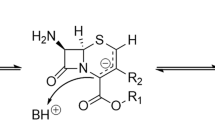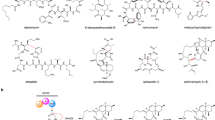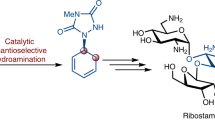Abstract
Studies of reactivity of antibiotic oligomycin A in various alkaline conditions showed that the compound easily undergoes retroaldol degradation in β-hydroxy ketone fragments positioned in the C7–C13 moiety of the antibiotic molecule. Depending on reaction conditions, the retroaldol fragmentation of the 8,9 or 12,13 bonds or formation of a product through double retroaldol degradation, when the fragment C9–C12 was detached, took place followed by further transformations of the intermediate aldehydes formed. The structures of the obtained non-cyclic derivatives of oligomycin A were supported by NMR and MS methods. NMR parameters demonstrate the striking similarity of the geometry (conformation) of the fragment C20–C34 in the non-cyclic products of retroaldol degradation and the starting antibiotic 1. The compounds obtained had lower cytototoxic properties than oligomycin A for human leukemia cells K-562 and colon cancer cells HCT-116 and lower activity against growth inhibition of model object Streptomyces fradiae. It cannot be excluded that the products of retroaldol degradation participate in the biological effects of antibiotic oligomycin A.
Similar content being viewed by others
Introduction
Oligomycin has been recognized as a potent inhibitor of the mitochondrial ATP synthase since 1958.1 It has been proposed that oligomycins specifically inhibit the proton translocation process associated with the F0F1-ATPase in the mitochondria. Recently, it was shown that the subunit c of the Fo portion of the F0F1-ATP synthase is the binding site of oligomycin.2 The molecular mechanism by which the antibiotic interacts with mitochondrial F0F1-ATPase remains obscure. At present, the main efforts are directed towards the study of subunits of the F0F1-ATP synthase as possible oligomycin-binding site(s). Whereas the mechanism of oligomycin interaction with F0F1-ATPase is under serious investigations in the past years,2, 3 relatively little is known about the structural basis for oligomycin A’s F0F1-ATPase activity and its potential interaction with other targets. Recently, we have prepared a series of oligomycin derivatives modified at the macrolactone ring,4, 5 at the side chain (at C33),6 and also that with the open macrolactone ring.7 Studies of structure–activity relationships for the model bacterial strain ATCC-19609, supersensitive to oligomycin, and cancer cells K-562 and HCT-116 permitted to suggest the existence of the target(s) beyond F0F1-ATP synthase that is important for the antitumor potency of oligomycin A. A part of the oligomycin A structure C5–C13 represents a highly reactive moiety containing several β-hydroxy ketone moieties capable of retroaldol degradation in relatively mild conditions. The aim of this work was to study the possibilities of retroaldol degradation of oligomycin A (1) in various conditions and preparation of novel oligomycin derivatives with the opened macrolactone ring. The identification and biological evaluation of new oligomycin A congeners provide an opportunity to develop a structure–activity relationship among this class of natural products.
Results and discussion
The first product (2) of retroaldol degradation of oligomycin A (1) with the intact lactone bond was obtained when 1 was stirred at room temperature with K2CO3 and n-Bu4NHSO4 in CHCl3 in phase-transfer conditions.7 Compound 2 was generated through the initial retroaldol fragmentation of the 8,9 bond. It is worth noting that in this case the retroaldol degradation occurred under mild conditions at room temperature, and the lactone bond was not hydrolyzed (Figure 1).
Earlier in the elucidation of oligomycins structures,8 an aldehyde 3a formed from oligomycin A (1) via retroaldol fragmentation of the 12,13 bond followed by the hydrolysis of the lactone bond was isolated. Similar transformation and formation of aldehyde 3b was described for oligomycin B containing an oxo group in position 28. In the same study, aldehyde 3c and its methyl ester were isolated.8
In this work, we studied the possibilities of oligomycin A degradation in various alkaline conditions. When NaOH was added to the solution of 1 at room temperature in ethanol, compound 4 was formed and was isolated in 12% yield (Scheme 1). The structure of compound 4 was supported by 1H and 13C NMR (Table 1), and also by HR-MS. In THF–methanol solution in the presence of BA(OH)2·8H2O, oligomycin A gave another retroaldol product 5 in 36% yield (Scheme 2), and the structure 5 was formed through double retroaldol degradation when the C9–C12 fragment was detached. Aldehyde 5 in ethanol in the presence of HCl provided acetal 6.
The comparison of compounds 4 and 5 and the starting antibiotic 1 revealed that in all these compounds the similar skeleton moiety C20–C34 with methyl groups connected with this fragment. All atoms with the similar numbers within this fragment in compounds 1, 4 and 5 have very close values of chemical shifts of 13C and 1H atoms, and also JH,H values. It demonstrates the similarity of the geometry (conformation) of the C20–C34 fragment in compounds 4 and 5 and the starting antibiotic 1 (Table 1). Similar chemical shifts and Jvic for atoms H13, H14 and CH3-40 represent the additional support for the presence of 14-C(CH3)CHO moieties in compounds 4 and 5. Similarly for compounds 2 and 5, parameters of 13C and 1H NMR for atoms C7, C8 and CH3-37 are very close (fragment 7-CO–CH2CH3).
Molecular composition of compound 5 was also supported by the presence of HR-ESI-MS ion (m/z: 683.4473 [M+Na]+) corresponding to the intramolecular disruptions between C8–C9 and C12–C13 bonds in 1 and splitting off of the fragment C8–C12 and ESI-MS fragmentations. Tandem MS/MS spectra of this compound generated by ESI and collision-induced dissociation multiple reaction monitoring mode showed that low collision energies (50–70 eV) led to the formation of unstable acyclic fragment ions corresponding to the loss of a fragment of acrylic acid (m/z: 487.3 [M+Na]+ ) and sequential loss of H2O (m/z: 469.3 [M+Na]+) (Figure 2).
Biology
We studied the antibacterial activity of novel compounds against Streptomyces fradiae ATCC-19609 strain that was extremely sensitive to 1 (<0.001 μmol l−1 or 0.0005 nmol per disk).9 This test system has been validated by us as an adequate model for the analysis of sensitivity to 1.9 The derivatives studied with this test system are shown in Table 2. Compounds 2, 4 and 5 had lower antibacterial activity than the parent antibiotic 1.
The cytotoxic potencies of compounds 1, 2, 4 and 5 were determined as described by us.6 The values of IC50 were defined as the concentration of a compound that reduced the number of viable cells by 50% (Table 3).
Experimental PROCEDURE
Chemistry
General procedures
Oligomycin A (1) (purity 95%) was produced at Autonomous Non-Commercial Research Center of Biotechnology of Antibiotics BIOAN (Moscow, Russian Federation), using Streptomyces avermitilis NIC B62. Fermentation was performed for 8 days at 28 °C in a liquid medium. Isolation and purification were performed by extraction with acetone–hexane mixture followed by crystallization. All other reagents and solvents were purchased from Aldrich (St Louis, MO, USA), Fluka (Buchs, Switzerland) and Merck (Darmstadt, Germany). The solutions were dried over sodium sulfate and evaporated under reduced pressure on a Buchi rotary evaporator at <35 °C. The progress reaction products, column eluates and all final samples were analyzed by TLC on Merck G60F254-precoated plates. Reaction products were purified by column chromatography on Merck silica gel 60 (0.04–0.063 mm) dards. The NMR spectra were recorded on Unity+400 (Varian, Palo Alto, CA, USA; 1H: 400.0 MHz; 13C: 100.6 MHz) and Avance 600 (Bruker, Karlsruhe, Germany; 1H: 600.0 MHz; 13C: 150.9 MHz) spectrometers. The solvent used was CDCl3, its signals in NMR 13C (δ 76.9) and the signal of residual protons in NMR 1H (δ 7.24) were internal standards. The NMR elucidation was made using homo 1H, 1H (COSY) and hetero 1H, 13C (HETCOR, heteronuclear single quantum coherence) 2D correlations as well as 1H and 13C 1D spectra of 1 and its derivatives. HR-ESI-mass spectra were recorded on micrOTOF-Q II Instrument (Bruker Daltonics GmbH, Bremen, Germany). HPLC analyses were performed on a Shimadzu HPLC Instrument (Kyoto, Japan) of the LC-20AD (2-System WAT, Colon Kromasil 100-C18, size 5 μm, 4.6 × 250 mm2, injection volume 10 μl, wavelength 230 nm). The concentration of samples was 0.02–0.05 mg ml−1. The systems contained (A) H2O or (B) acetonitrile. The proportion of acetonitrile varied from 80 to 95% for 15 min and then 95% for 20 min, flow rate 1 ml min−1. Retention time for 1 was 10.46 min. UV spectra were obtained on a UV/visible double-beam spectrometer UNICO (Dayton, NJ, USA) in methanol. IR spectra were recorded on Thermo Nicolet iS10 (Thermo Scientific, Waltham, MA, USA).
Preparation of compound 4. Oligomycin A (1) (0.1 g, 0.13 mmol) was dissolved in the mixture EtOH–H2O (5:1, 15 ml) and NaOH (0.005 g, 0.1 mmol) was added and stirred at room temperature for 1 h. The reaction mixture was analyzed by TLC in CH2Cl2–acetone (10:2), and the staining reagent for TLC was anisaldehyde–sulfuric acid in ethanol. The reaction mixture was extracted with EtOAc, washed with water to pH 7.0, dried over Na2SO4 and concentrated. The reaction product was purified by column chromatography (silica gel; Merck) in CH2Cl2–acetone (20:2) and the purification was repeated in toluene–EtOAc–EtOH (10:5:0.1) to give 0.012 g (0.015 mmol), 12% of the product 4 as a colorless amorphous powder, retention time 12.93. MW was calculated for C45H74O11 790.5231, found in HR-ESI-mass spectrum (m/z) 813.5144 (M+Na)+. UV-spectrum (λmax nm, MeOH), 230 nm. IR ν max, cm−1 (film) 3478, 2965, 2935, 2875, 1724, 1457, 1385, 1353, 1317, 1255, 1222, 1192, 1173, 1135, 1093, 1056, 986, 915, 887.
Preparation of compound 5. Oligomycin A 1 (0.1 g, 0.13 mmol) was dissolved in the mixture THF–MeOH (2:1, 15 ml) and BA(OH)2·8H2O (0.060 g, 0,19 mmol) was added and stirred at room temperature for 1 h. The reaction mixture was analyzed by TLC in CH2Cl2–acetone (10:2), and the staining reagent for TLC was anisaldehyde–sulfuric acid at ethanol. The reaction mixture was extracted with EtOAc, washed with water to pH 7.0, dried over Na2SO4 and concentrated. The reaction product was purified by column chromatography (silica gel, Merck) in CH2Cl2–acetone (20:2) and the purification was repeated in toluene–EtOAc–EtOH (10:5:0.1) to give yield 36% product 5 as a colorless oil 0.030 g (0.055 mmol), Rt 14.44. MW was calculated for C39H64O8 660.4601, found in HR-ESI-mass spectrum (m/z) 683.4448 (M+Na)+. UV-spectrum (λmax nm, MeOH), 229 nm. IR ν max, cm−1 (film) 3478, 2965, 2935, 2875, 1713, 1632, 1458, 1383, 1282, 1224, 1189, 1136, 1096, 1057, 986.
Preparation of acetal 6. The product 5 (0.03 g, 0.045 mmol) was dissolved in EtOH (10 ml) and conc. HCl was added to, pH 2, the mixture and was stirred at room temperature for 24 h. The reaction mixture was analyzed by TLC in toluene–EtOAc–EtOH (10:5:0.1), and the staining reagent for TLC was anisaldehyde–sulfuric acid at ethanol. The reaction mixture was extracted with EtOAc, washed with water to pH 7.0, dried over Na2SO4 and concentrated. The reaction product was purified by column chromatography (silica gel; Merck) in toluene–EtOAc–EtOH (10:5:0.1) to give yield 80% product 6 as a colorless oil 0.026 g (0.035 mmol), Rt 15.01. MW was calculated for C43H74O9 734.5328, found in HR-ESI-mass spectrum (m/z) 757.5172 (M+Na)+. UV-spectrum (λmax nm, MeOH), 229 nm. IR ν max, cm−1 (film) 3478, 2968, 2931, 2875, 1711, 1651, 1457, 1377, 1272, 1223, 1188, 1097, 1056, 984.
1H-NMR (δC, p.p.m.): 24.58(C34), 14.33, 11.63, 11.61, 11.15, 9.38, 7.49, 5.53 (eight CH3 groups); 42.43, 35.14, 34.67, 33.55, 31.38, 30.04, 27.72, 26.44, 25.86 (nine CH2 groups); 47.45, 44.51, 39.91, 37.81, 36.65, 35.43, 30.39 (seven CH-CH3 (–CH2–) groups); 0.24(–O–CH–O–, C13), 76.16, 73.27, 69.42, 67.16, 64.59 (six CH–O–(–O–CH–O–) groups); 149.73, 136.46, 131.95,130.19, 129.86, 121.80 (six CH=groups); 216.55 (CO, C7), 165.81 (COO, C1), 99.05 (–O–C–O–, C27) (three Cq groups); 2 CH2: 62.08, 61.86; 2 CH3: 15.21, 15.23 (C13–(OCH2CH3)2. Atoms in positions C9–C12, C38 and C39, which are present in oligomycin, are absent in 6.
Biology
Studies of cytotoxicity of compounds and the antibacterial activity
The antibacterial activity of 1 and its degraded derivatives 4, 5 was determined as the diameter of growth inhibition zone of S. fradiae cells around paper discs filled with tested compounds as described previously.6
Conclusion
Two novel products of retroaldol degradation of oligomycin A were obtained under the action of NaOH in in the mixture EtOH–H2O or BA(OH)2·8H2O in the mixture THF–MeOH. These non-cyclic derivatives of I with no hydrolyzed lactone bond were characterized by NMR and MS methods. It is worth mentioning that according to NMR data (δ, p.p.m. and Jvic values), the conformations of the untouched fragments C20–C34 in compounds 4, 5 and the starting antibiotic 1 (and also previously described retroaldol product 2) are similar. However, compounds 2, 4 and 5 had low activity against S. fradiae ATCC-19609 strain, which was extremely sensitive to 1 (<0.001 nmol ml−1 or 0.0005 nmol per disk). It suggests that the labile fragment C7–C13 is very important for the interaction with F0F1-ATPase. The compounds were not active in spite of the presence of highly conserved the ‘down’ macrolactone part and the side chain C32–C33 with a hydroxyl group hydrogen bonded to the side chain of Glu59 of ATPase.2 At the same time, we cannot exclude the possibility of the formation of retroaldol degradation oligomycin products in biological conditions and exclude their role in the biological effects of the antibiotic. The cytotoxic properties of novel compounds are also decreased.
Recently, studies of the high-resolution crystal structure of oligomycin bound to the subunit c of the yeast mitochondrial F0F1-ATP synthase revealed that oligomycin binds to the surface of the c ring.2 The carboxyl side chain of Glu59, which is essential for proton translocation, forms an H bond with oligomycin via a bridging water molecule. The remaining contacts between oligomycin and subunit c are primarily hydrophobic, and the hydrophobic effect is likely the largest contributor to the binding energy. The hydrophobic face of the oligomycin molecule covers the hydrophobic face of subunit c, and the hydrophilic face of oligomycin is predominantly exposed to the bulk solvent.2 Our compounds 2, 4 and 5 with the degraded C7–C12 fragment still contain the non-distorted hydrophobic part and the propanol moiety C32–C33(OH)–C34 essential for binding to Glu59. However, structural changes that result from retroaldol degradation in compounds 2, 4 and 5, in particular, degradation of the C7–C13 macrolactone hydrophilic moiety, led to the decrease of anti-F0F1-ATP synthase activity and significantly altered the interaction with the subunit c of F0F1-ATP synthase. These SAR considerations demonstrate the essential role of the hydrophilic moiety of 1 for binding of this drug to its major target.

Retroaldol degradation of oligomycin A (1) under the action of NaOH in ethanol at room temperature.

Retroaldol degradation of oligomycin A (1) under the action of Ba(OH)2 in THF–MeOH at room temperature.
References
Lardy, H. A., Johnson, D. & McMurray, W. C. Antibiotics as tools for metabolic studies. I. A survey of toxic antibiotics in respiratory, phosphorylative and glycolytic systems. Arch. Biochem. Biophys. 78, 587–597 (1958).
Symersky, J., Osowski, D., Walters, E. & Mueller, D. M. Oligomycin frames a common drug-binding site in the ATP synthase. Proc. Natl Acad. Sci. USA 109, 13961–13965 (2012).
Arato-Oshima, T., Matsui, H., Wakizaka, A. & Homareda, H. Mechanism responsible for oligomycin-induced occlusion of Na+ within Na/K-ATPase. J. Biol. Chem. 271, 25604–25610 (1996).
Lysenkova, L. N., Turchin, K. F., Danilenko, V. N., Korolev, A. M. & Preobrazhenskaya, M. N. The first examples of chemical modification of oligomycin A. J. Antibiot. 63, 17–22 (2010).
Lysenkova, L. N. et al. Synthesis and properties of a novel brominated oligomycin A derivative. J. Antibiot. 65, 223–225 (2012).
Lysenkova, L.N. et al. Synthesis and cytotoxicity of oligomycin A derivatives modified in the side chain. Bioorg. Med. Chem. 21, 2918–2924 (2013).
Lysenkova, L.N. et al. A novel acyclic oligomycin A derivative formed via retro-aldol rearrangement of oligomycin A. J. Antibiot. 65, 405–411 (2012).
Carter, G. T. Structure determination of oligomycins A and C. J. Org. Chem. 51, 4264–4271 (1986).
Alekseeva, M.G., Elizarov, S. M., Bekker, O. B., Lubimova, I. K. & Danilenko, V. N. F0F1ATP synthase of streptomycetes. Modulation of activity and oligomycin resistance by protein Ser/Thr kinases. Biochemistry (Moscow) Suppl. Ser. A 3, 16–23 (2009).
Acknowledgements
This study was supported by the program ‘Research and development of priorities of scientific and technological complex of Russia in 2007–2012’, contract no. 02.512.12.2056, 2009 “Development and validation of test systems for screening of oligomycin A derivatives” and the grant of Russian Foundation for Basic Research 10-03-00210-a.
Author information
Authors and Affiliations
Corresponding author
Rights and permissions
About this article
Cite this article
Lysenkova, L., Turchin, K., Korolev, A. et al. Study on retroaldol degradation products of antibiotic oligomycin A. J Antibiot 67, 153–158 (2014). https://doi.org/10.1038/ja.2013.92
Received:
Revised:
Accepted:
Published:
Issue Date:
DOI: https://doi.org/10.1038/ja.2013.92
Keywords
This article is cited by
-
Verification of oligomycin A structure: synthesis and biological evaluation of 33-dehydrooligomycin A
The Journal of Antibiotics (2017)





